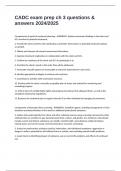CADC exam prep ch 3 questions &
answers 2024/2025
Competencies & goals of treatment planning - ANSWERS1. Explain assessment findings to the client and
SO's involved in potential treatment.
2. Provide the client and SO's with clarification and further information on potential treatment options
as needed.
3. Obtain and interpret all relevant assessment information.
4. Examine treatment implications in collaboration with the client and SO's.
5. Confirm the readiness of the client and SO's to participate in tx.
6. Prioritize the client's needs in the order they will be addressed.
7. Formulate mutually agreed on measurable tx outcome statements for each need.
8. Identify appropriate strategies to achieve each outcome.
9. Coordinate tx activities with community resources.
10. Develop with the client a mutually acceptable plan of action and method for monitoring and
evaluating progress.
11. Inform client of confidentiality rights and program procedures that safeguard them, as well as the
exceptions imposed by regulations.
12. Reassess the treatment plan at regular intervals &/or when indicated by changing circumstances.
Components of thorough client screening - ANSWERS1. Establish rapport, including management of crisis
situations and determination of the need for additional professional assistance.
2. Gather data systematically from client and other collateral sources using screening instrument & other
methods that are sensitive to age, developmental level, culture, and gender. At a minimum, data should
include current and historic substance use; health, mental health, and substance-related tx history;
mental status; and current social, environmental &/or economic constraints.
3. Screen for psychoactive substance toxicity, intoxication, and withdrawal symptoms; aggression or
danger to others; potential for self-inflicted harm or suicide; and coexisting mental health problems.
4. Assist clients in identifying impact of substance use on current life problems and effects of continued
use.
, 5. Determine clients' readiness for tx and change as well as the needs of others involved in current
situation.
6. Review tx options that are appropriate for clients' needs, goals, characteristics, and financial
resources.
7. Apply accepted criteria for dx of substance use disorders in making tx recommendations.
8. Construct with clients and appropriate others an initial action plan based on clients' needs,
preferences, and available resources.
9. Based on initial action plan, take specific steps to initiate an admission or referral to ensure follow-
through.
Diagnostic summary - ANSWERSOrganizes all the available assessment information into an integrated
interpretation of the client's current status including personal history, strengths, & challenges.
- Includes (but is not limited to): mental status, risk assessments, tx history, reasons for treatment,
physical health and nutritional status, substance use history, obstacles to recovery, work history, intimate
relationships and sexuality, beliefs & values, financial & education hx, military experiences, legal
problems, hobbies, personal assets & liability, special issues, and readiness to learn.
Mild severity - ANSWERSFew, if any, symptoms in excess of those required to make the diagnosis, and
the symptoms result in no more than mild impairment in occupational functioning or in usual social
activities or relationships with others. (2-3 symptoms)
Moderate severity - ANSWERSSymptoms or functional impairment between "mild" & "severe". (4-5
symptoms)
Severe severity - ANSWERSMany symptoms in excess of those required to make the dx, and the
symptoms markedly interfere with occupational functioning or with usual social activities or
relationships with others. (6+ symptoms)
Early full remission - ANSWERSFor at least 1 month but less than 12 months, no diagnostic criteria have
been met.
Early partial remission - ANSWERSFor at least 1 month but less than 12 months, some, but not all,
diagnostic criteria have been met.




